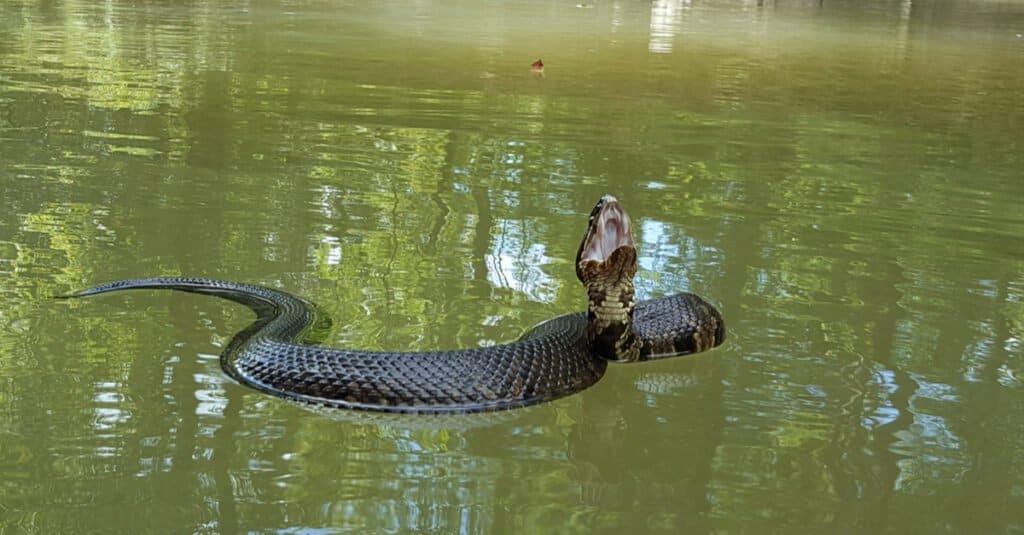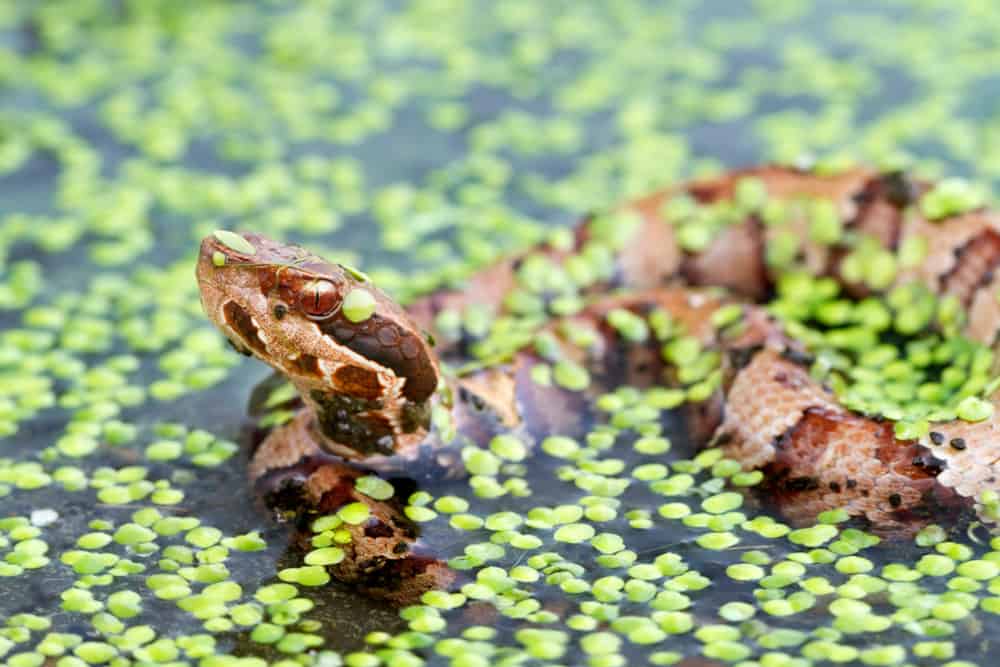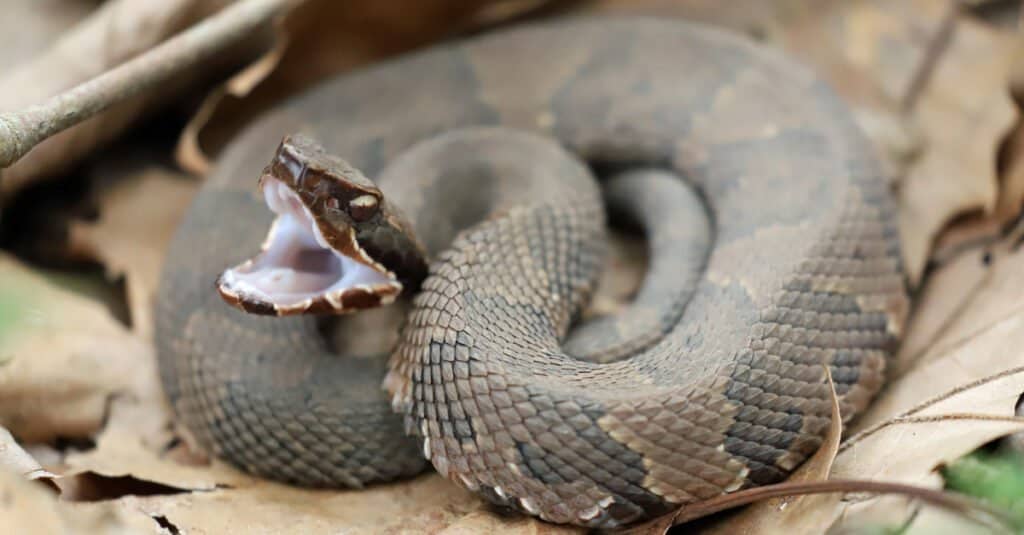Agkistrodon piscivorus, the cottonmouth snake, takes its name from the interior of its mouth, which is white like cotton when it opens. It goes by the names water viper or water moccasin. The Louisiana cottonmouth is primarily found in marshes and other bodies of water in the Southeast of the United States.
Although cottonmouths enjoy sunbathing on logs and branches during the daylight hours, they are mostly active at night. It is a heavy-bodied, lethargic snake that can grow up to six feet long and is infrequently encountered far from water.
As a result, it consumes aquatic creatures like frogs, fish, young turtles, other snakes, wading birds, and other tiny animals that are found near water. Even carrion has been found to be consumed by them, which is rare for snakes.

Cottonmouths can reach lengths of just over six feet and weights of under four pounds.
©Seth LaGrange/Shutterstock.com
What Does a Louisiana Cottonmouth Look Like?
Cottonmouths can reach lengths of just over six feet and weights of under four pounds. Men are bigger. Both sexes have huge heads with a spade-like form with a black, brown, or olive splotch on top or on the sides.
The adults frequently have brown and black lines on their bodies, however, these may be difficult to discern from a distance. Towards the animal’s tail, these rings become completely black. Juvenile cottonmouths have yellow tail tips that are utilized as lures. Compared to the adult patterns, theirs are more colorful.

The cottonmouth snake takes its name from the interior of its mouth, which is white like cotton when it opens.
©Jay Ondreicka/Shutterstock.com
Louisiana Cottonmouth Behavior
Rarely does this kind of snake venture too far from the water. Adults are particularly affected by this. While they live alone, the males attempt to establish dominance during the mating season. Being pit vipers, they often hunt at night and are proficient at doing so.
This indicates that they have heat-sensitive pits between their eyes and nostrils on their faces. They don’t need to see their prey in order to attack because the pits enable them to detect them so precisely. They have excellent senses of touch, smell, hearing, and vision.
Louisiana cottonmouths lack hearing like all snakes, but they are nonetheless able to detect ground vibrations. A cottonmouth snake’s home range is a little more than 100 acres and includes mostly bodies of water. Male serpents have a larger range than females, and larger snakes have bigger habitats.

The Louisiana cottonmouth is primarily found in marshes and other bodies of water in the Southeast of the United States.
©Mark_Kostich/Shutterstock.com
Louisiana Cottonmouth Reproduction
Although the Louisiana cottonmouth can mate all year, it does so most frequently in the spring. For almost five months, the female stores her eggs inside of her. There may be one to 16 young that come out when the eggs burst open inside of her.
Given that gender in Louisianna cottonmouths is decided by genes rather than external factors like in turtles and crocodiles, they are quite rare among reptiles. Before leaving for the world, the newborns spend a little period of time with their mother, who may watch over them for a while.
The majority do not reach adulthood because other animals, particularly snakes of their own species, consume them. The male snake dances to entice the female toward him prior to actually mating. Louisiana cottonmouths are remarkable for appearing to be monogamous as well.
At three years old is when female cottonmouths reach sexual maturity. The oldest cottonmouth snake was 24.5 years old when it died. As this snake was raised in captivity, it is unknown how long it might survive in the wild.
Are Lousianna Cottonmouths Dangerous?
Cottonmouths can be found in Louisiana’s marshes and swamps, just like they can be found in any area with a lot of stagnant water. Although incidental contact causes the majority of bites, an adult human can die from the cottonmouth’s venom if not treated quickly.
Around 1% of all fatal snake bites in the United States, each year are caused by cottonmouths. We are unable to accurately estimate how frequently cottonmouths truly bite in Louisiana due to the lack of trustworthy information.
Although not as lethal as some of the other varieties, cytotoxic venom still has some very dangerous side effects. This is the type of venom that a Louisiana cottonmouth releases upon puncture.
The way cytotoxic venom causes tissue damage is one of the biggest problems with it. Its potent venom can result in severe blistering, cell death, and necrosis (tissue death). In the worst scenarios, amputation may be necessary.
Cottonmouths not only have strong venom, but also a lot of venoms. The usual amount of venom in each bite is 125 mg, however, on certain rare occasions, this amount might reach 237 mg.

Around 1% of all fatal snake bites in the United States, each year are caused by cottonmouths.
©KF2017/Shutterstock.com
Treating a Bite From a Cottonmouth
Cottonmouth poison is hazardous even though it isn’t thought to be as lethal as the venom generated by a number of other snakes. As a result, you must seek medical attention right away because there is no time to waste.
Despite the bite appearing to be not very painful, if it is not treated, it can quickly worsen. Fortunately, anti-venom is available to treat cottonmouth bites, and in most cases it is effective.
You may have heard tales about how to treat wounds with snake venom. Therefore, you should never take this action. Instead, as you wait for medical assistance, keep the injured limb raised above heart level. Regardless of how severe the wound is, avoid applying any ice to it.
The photo featured at the top of this post is © Kristian Bell/Shutterstock.com
Discover the "Monster" Snake 5X Bigger than an Anaconda
Every day A-Z Animals sends out some of the most incredible facts in the world from our free newsletter. Want to discover the 10 most beautiful snakes in the world, a "snake island" where you're never more than 3 feet from danger, or a "monster" snake 5X larger than an anaconda? Then sign up right now and you'll start receiving our daily newsletter absolutely free.
Thank you for reading! Have some feedback for us? Contact the AZ Animals editorial team.






